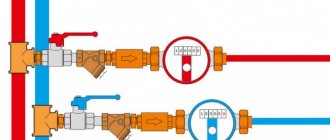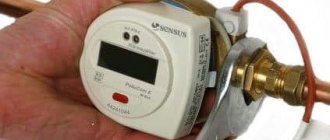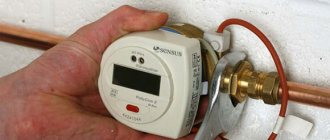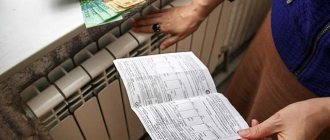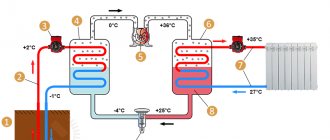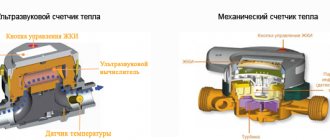The need to install a heat meter
First of all, consumers of services provided by utility companies need to know that a heat meter for heating does not save heat and money, it is only a metering device.
After installing a heat meter, you can receive bills with much lower amounts payable only if a number of measures have been completed, including:
- high-quality insulation of the house;
- high-quality glazing in entrances;
- replacing window frames with metal-plastic products;
- covering the facades with a “fur coat” made of polystyrene foam or mineral wool.
Of course, the most beneficial for property owners is to install heat meters individually in each apartment (for more details: “Installing heating meters in an apartment: types of devices”). Provided that the entrance to the building is not insulated and the street is heated, and the apartment is poorly insulated, the payment for heating will be higher.
Subscribers using the centralized heating services of an apartment building should understand that regardless of whether installing house meters, such as in the photo, is profitable or not, this does not affect the need to use heat meters, since according to Russian Federal Law No. 261, residential buildings are required to order you need to equip them (
Maintenance
Maintenance of the meter consists of maintaining thermal equipment in working condition, regular inspection, eliminating causes affecting wear and tear, checking the operation of primary converters on the return and supply pipelines of the heating network, checking the correct functioning of the meter, checking the operation and circuits of resistance thermal converters, weekly printout of readings for analysis and development of recommendations for maintaining the required temperature and much more.
If necessary, during the maintenance process, work is carried out to dismantle (remove and disconnect) faulty devices and reinstall the meter after a secondary check and repair.
Payment calculation procedure
There are several ways to calculate payment when communal heating meters are installed.
Option one
– the apartment does not have an individual heat consumption meter. A similar situation can be observed in houses built in Soviet times.
Back then, when installing heating systems, rack-mount structures were used, in which, to account for heat, it was necessary to install meters on each radiator, which was a very expensive undertaking from a financial point of view.
First you need to determine the cost of heating per square meter. The heat consumption recorded by a building-wide heat meter at current tariffs is divided by the entire area of the building, taking into account residential and non-residential premises that are heated.
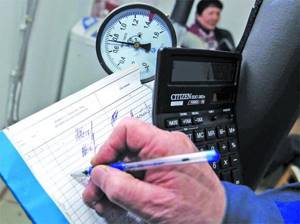
Since the share in common property depends on the area of the apartment, you need to calculate it. Then the area of the apartment and the area of its share in the home property are summed up. The result is multiplied by the price of heating one “square”.
Option two
– individual heat consumption metering devices are installed in the house, apartment by apartment. In new buildings and buildings erected after 2000, the distribution from the risers inside the apartment has become horizontal, making it possible to install one apartment heat meter. In this case, the owners pay for the heating of the apartment after taking readings from an individual meter.
To determine the amount of heat spent on heating the common area (entrances, attics, etc.), calculate the difference between the data recorded by the general heating meters and all individual meters. The share of each apartment in the heat costs spent for general needs is calculated in the same way as it was done in the first option.
Option three
– if one apartment does not have an individual heat consumption meter, while others have them. An individual heat meter, even without payment for installation services, costs consumers a significant amount, so not everyone purchases such a device.
In this case, the payment calculation scheme looks like this:
- record heat consumption according to the readings of all individual and communal meters;
- the difference obtained between them is equal to the cost of heating the common area and apartments without heat meters. Based on these data, you need to determine the amount of payment for heating one “square”;
- then you should calculate the amount of payment depending on the area of the apartment in which heat meters are not installed, and on the share in the common property.
Water meters: operating hours and verification
So, all other organizations and enterprises, as well as their representatives, who hint at the need for it to be carried out at some specific moment or right now, or propose to replace the old water meter with a new meter due to the expiration of its service life, At the very least, they mislead the resource consumer.
- Agreement for the installation of water meters in the apartment (in 2 copies);
- Maintenance agreement (in 2 copies);
- Certificate of completed work (in 2 copies);
- Certificate of putting into use (in 2 copies);
- Passports for metering devices (1 copy);
- Certification documents.
Measures to save on heating
What actions can be taken to make real savings?
First of all, install an individual heat meter plus thermostatic heads or throttles. In this case, the consumer will pay for the heat that he really needs to ensure comfortable living conditions. At the same time, the apartment owner becomes less dependent on the behavior of his neighbors. To implement such measures, you can install a heat meter at the point where heating is introduced into the apartment, which must be sealed by employees of the heat supply organization. Thermostats or chokes are installed on the connections to heating devices. Cheaper in cost are chokes. In some cases, you can entrust the adjustment even to ordinary valves. But it is quite difficult to regulate the temperature of the coolant in the radiator using them. Experts do not recommend using screw valves for these purposes, since the rubber gaskets in them can block the gap and leave the room without heat.

Mechanical or digital thermostats are considered ideal devices. Their head should be installed so that they do not fall into the flow of hot air rising upward from the heating device. After calibration, the thermostatic head is able to maintain the required degree of supply necessary to maintain the desired temperature in the room.
Many owners of apartments with rack-type heating systems are interested in how to solve the problem taking into account the consumed thermal energy, because installing metering devices on each radiator will cost a considerable amount of money.
In addition to significant initial costs, the consumer will have to periodically pay for their maintenance, verification and repairs in the event of a breakdown. Perhaps a special heat dispenser shown in the photo will help solve this problem. It is an electronic thermometer that constantly takes and records the temperature of the surface of the battery and the air in the room. This device is inexpensive and can be installed independently by attaching directly to the surface of the radiator.
Based on the thermal power of each battery, the temperature of the radiator and air throughout the month and the total consumption of thermal energy by all heating devices, the heat consumption in a separate apartment is calculated. As a result, the property owner has an incentive to save on heating costs, since he only has to pay his own expenses.
Commissioning
The installed collective meter is approved for operation by a commission consisting of:
- A representative from the company that installed and commissioned the equipment being put into operation.
- Consumer representative.
- Representative of a company supplying thermal energy.
The commission must be created by the owner of the heating unit. During the commissioning process, the commission checks the following:
- Availability of passports, factory seals and verification certificates.
- Compliance with the design documentation of the components of the heating unit.
- Compliance with permissible temperature curves, measurement ranges and hydraulic operating modes, parameter values determined by the conditions of connection to the heating system and the contract.
- Compliance of the characteristics of measuring instruments with the characteristics specified in the device passport.
If there are no comments, the commission must sign the act of commissioning the meter installed at the consumer. This document is the basis for keeping records of coolant on the meter, heat energy, quality control and heat consumption mode using the data received from the moment the document is signed.
Problems with heat accounting
The implementation of federal law number 261 is associated with a lot of problems. The fact is that the initiators of the innovations were the Russian government, but the material costs fall on the residents - they are the ones who must pay the cost of communal heat meters and their installation services. The expenses that must be paid to property owners can sometimes amount to huge sums. If there are few apartments in a building, their owners will have to invest a lot of money in installing a common house meter. The fewer apartments there are in a building, the higher the amount each tenant must pay. This law does not apply to buildings that are subject to demolition and are in disrepair and those houses in which the cost of the meter and its installation is comparable to a 6-month payment for heat consumption. If the apartment is not privatized, its residents do not pay for the installation of metering devices. These costs are borne by the municipality. Maintenance of the heat meter includes periodic cleaning of filters and mud traps, repairs of shut-off valves located in front of and after the meter. After completion of the 12-month warranty, the cost of repair work also falls on the shoulders of thermal energy consumers. This expense item is included in the receipt for housing maintenance. Thus, apartment owners, regardless of whether the meter is working or broken, are forced to pay for repairs to the device.
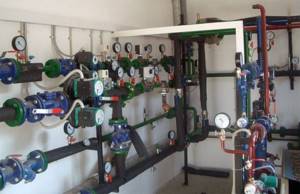
On the one hand, she needs to pay monthly for the consumed thermal energy, because in the absence of payment, the heat supplier has the right to stop supplying it by closing the valves in the well. When severe frost sets in, turning off the heat in the house will certainly lead to serious consequences. But on the other hand, there are always defaulters among property owners. Each management company solves problems with late payment differently. As practice has shown, there have been cases when heat debt was distributed among apartments whose residents regularly made monthly payments. In addition, the adopted law does not contain clear instructions regarding the actions of consumers in the event that the device fails. There has been information in the media more than once that as a result of the failure of the metering device, consumers were billed for inflated amounts. As a result, the problem with their payment was resolved by the authorities in the following way: residents were provided with an installment plan to pay off the resulting debt.
A heat meter is a complex device and can fail at any time. Therefore, in order to eliminate the negative consequences of a breakdown, an additional control system is needed. But this point is not reflected in the law.
Is it worth installing communal heating meters, see the video for details:
Additional technical information
- If the heat consumption is insignificant, and the heating system has a high pressure, the installation of inexpensive mechanical meters is allowed. When, on the contrary, the flow rate is significant and the pressure is small, the consumption of thermal energy will be recorded more accurately by an electromagnetic or ultrasonic device. By the way, most of the installations include house-wide ultrasonic devices.
- In addition to heat, metering devices record the consumption of hot water; now modern device models count coolant with a temperature of less than 40 degrees as cold, which is reflected in the amount of payment for heat supply.
- A useful measure for an apartment building would be to conduct an energy audit to identify the causes of heat loss. Then measures should be taken to eliminate them. Of course, such work will be expensive.
- When it is decided to install a mechanical meter, in addition to installing coarse filters, it is necessary to use a magnetic-mechanical filter in steel pipes to retain scale and rust. It is capable of filtering out metal particles that are so small that they pass through the mesh.
Flaws
It is also worth paying attention to the disadvantages of these meters. They are not suitable for use if there is a high level of hardness in the water circulating through the system. Another negative point that may affect the installation of this equipment is the presence of various impurities in the coolant.
All these conditions can lead to frequent clogging of the filter, which provokes a decrease in the coolant pressure level. For this reason, meters of this type are usually used in private homes.

